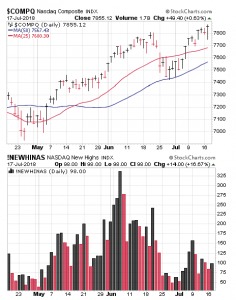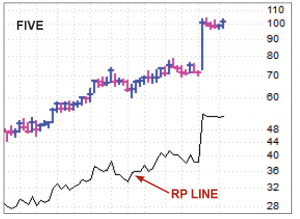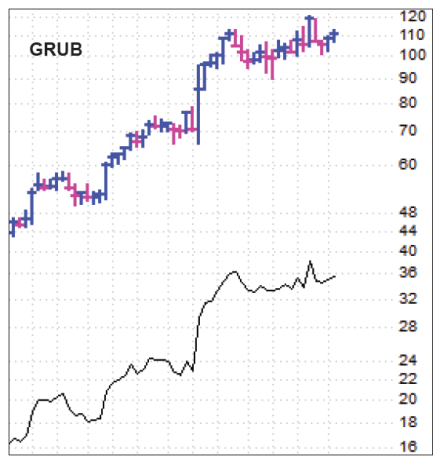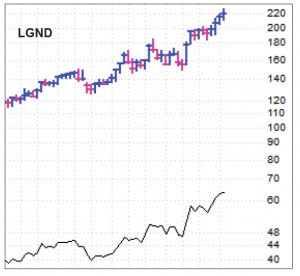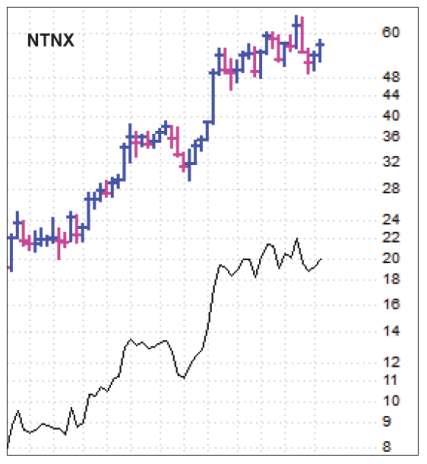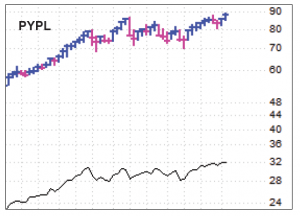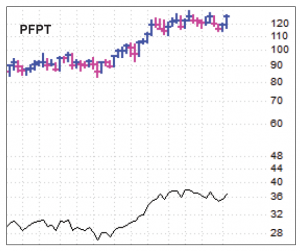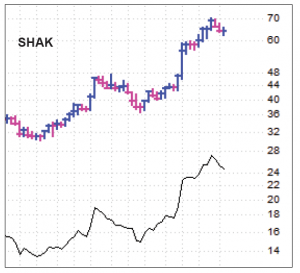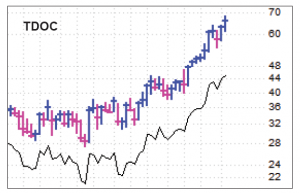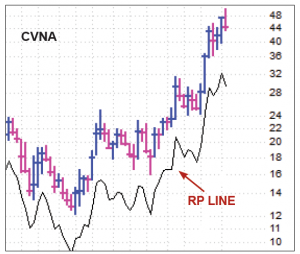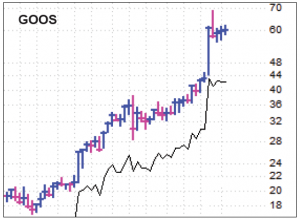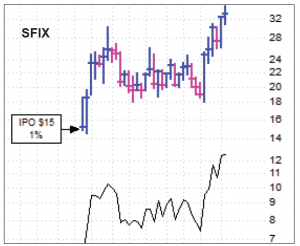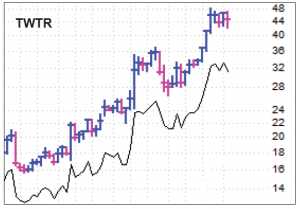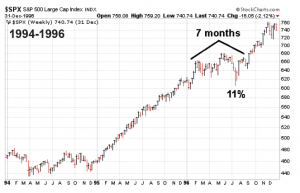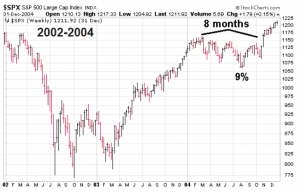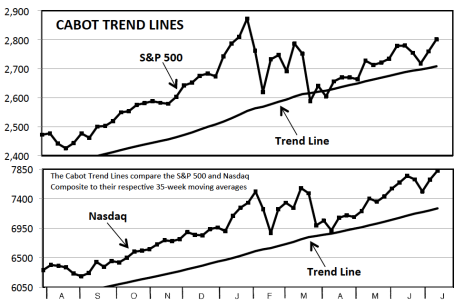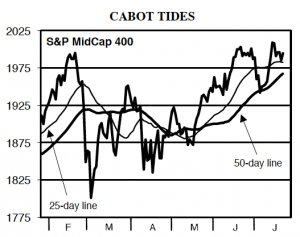The market’s action since its late-June shakeout has been solid, with the major indexes and many leading stocks pushing back toward new high ground. Granted, not everything looks perfect, but the majority of evidence remains positive, including our trend-following indicators, so we remain mostly bullish.
Cabot Growth Investor 1398
[premium_html_toc post_id="154166"]
Not Perfect, But Pretty Good
Just about every morning when we check the financial media’s scuttlebutt, about 80% of the news is negative. Many of these are fundamental—the trade war, the Fed’s rate hike path and unwinding of its balance sheet—though some concern the market itself, including fears of a yield curve inversion (often a recession signal) and the fact that much of the gains this year have come from a handful of mega-cap technology stocks.
While these factors don’t make it onto our radar screen, there are a few things that have us raising an eyebrow. As the market has snapped back from its late-June shakeout, for instance, fewer stocks have been participating—while the Nasdaq and most other major indexes have nosed back above their June high, the number of stocks doing the same is down dramatically. Also, volume has been sub-par (12 straight days of less-than-normal volume) as the indexes have moved higher, and we’ve started to see money coming out out of small- and mid-caps and into defensive areas of the market.
In short, conditions aren’t perfect. But that’s not unusual! In the market you can almost always find something to worry about. What matters is the weight of the evidence, and today, while it’s not perfect, things look pretty good.
Happily, our Cabot Tides survived the June shakeout and is now back in a positive stance; the intermediate-term trend has rejoined the longer-term trend on the upside. And, while the number of new highs has declined, we’re seeing a lot of stocks that were resting in May and June begin to perk up. All told, growth stocks (including most in the Model Portfolio) are doing just fine.
What we really think is going on here is rotation, not just among sectors, but from later-stage, more obvious stocks (like Netflix) to newer growth stocks that have only begun their runs during the past few months. That’s where our focus is on the buy side, in “fresher,” more vibrant growth stocks that have the best chance of moving higher if the market does.
[highlight_box]WHAT TO DO NOW: Because the picture is less than perfect and the uncertainty of earnings season beginning, the Model Portfolio is still holding onto 20% in cash. But with most of the evidence bullish, we’re mostly invested, and added two new stocks last week—Ligand Pharmaceuticals (LGND) and Teladoc (TDOC). Details inside.[/highlight_box]
Model Portfolio Update
The Model Portfolio has been gyrating with the market during the past month, with most stocks taking a hit during the second half of June before snapping back the past two weeks. Our cash position has also done a round trip, starting at 20%, rising to 40% when we got knocked out of two positions (because of individual stock action, not a general market call) and now, after buying Ligand and Teladoc last week, back down to 20% or so.
From here, our focus will be on earnings season for our holdings, for the market and for any potential new leaders that may emerge. We’ll probably wait for a bit to see how reports are being received before deciding what to do with our remaining cash.
Current Recommendations
BUY—Five Below (FIVE 107)—FIVE pushed to new highs today on solid volume. This comes after a few weeks with next to no selling pressure coming into the stock despite the market’s recent wobbles and FIVE’s huge leap a month ago. That doesn’t mean sellers can’t show up at some point, but as we’ve written before, the longer the stock holds up after a big move, the greater the odds that it continues higher as big investors build positions, and that seems to be playing out here. We’re also pleased to see resilience among some specialty retailers (Canada Goose, Lululemon, etc.) in particular. Bigger picture, after five years of improving fundamentals but no net stock progress, FIVE broke out last November, and June’s moonshot looks like a change-of-perception moment among institutional investors, more of whom will pay up for future growth they believe is likely to come. We’ll stay on Buy, preferably on dips.
HOLD—Grubhub (GRUB 114)—GRUB has been all quiet on the news front since announcing its partnership with Jack in the Box for delivery services and point-of-sale technology integration back in early May. But that will change next week—Grubhub will report earnings next Wednesday morning (July 25), with analysts expecting revenues of $233 million (up 47% from a year ago) and earnings of 41 cents per share (up 58%), though user growth, cash flow figures and any updates on the integration of Yum! Brands and Jack in the Box will also be key. As for the stock, the failed breakout in June was a bummer, but GRUB held support near the century mark and the bounce since then has been solid (not amazing), gaining back about three quarters of the drop. All told, Hold remains the appropriate rating for our small position; a large gap down would be a red flag given the stock’s sideways movement during the past few months, but a big positive reaction could start a new leg up (and possibly have us adding to our position). We’ll be watching.
BUY—Ligand Pharmaceuticals (LGND 227)—LGND was added to the Model Portfolio last week, and we’re optimistic the stock is finally freewheeling after a big consolidation in late 2016 and all of 2017 and a couple of false starts earlier this year. The company meaningfully boosted its 2018 earnings outlook near the end of last month thanks to a one-time milestone payment from Wuxi Pharmaceuticals for expanded use of Ligand’s OmniAb research platform; even with some added spending, the top brass expects earnings north of $6 per share this year, up 90% from a year ago! That said, what we’re really watching is the firm’s royalty revenue, which is less lumpy—royalties are expected to total $116 million this year, up 30% from a year ago, and there’s more where that came from as current drugs on the market grow (especially two big ones being marketed by Novartis and Amgen) and new treatments from partners hit the market. Earnings are due out August 6, which is always a risk, but given that the firm has already preannounced results, the chance of a surprise is lower. You can buy some around here or on dips of a few points.
HOLD—Nutanix (NTNX 58)—NTNX has bounced pretty well during the past two weeks, recouping about half of its late-June decline. Fundamentally, one analyst said recently that, based on partner checks, Nutanix is seeing accelerating momentum when it comes to landing contracts from the Federal government, including what could possibly be the company’s largest deal ever last quarter. We continue to think the firm’s leading position in the hyperconverged infrastructure movement will pay big dividends, with booming sales and bookings likely for a long time to come. Back to the stock, net-net, it didn’t do anything from mid-March through the end of June, which should be enough of a rest; if all’s well, we’d expect NTNX to generally work its way higher from here, assuming the market does the same. (A drop below the 48 to 49 area would probably have us bailing.) Right now, we’re encouraged by the rebound and advise holding your shares.
HOLD—Okta (OKTA 56)—OKTA has perked up nicely as it tests resistance in the mid-50s, a good sign that its base-building phase is going according to plan. On the weekly chart (shown here), you can see the wild early-June action looks relatively normal compared to the prior uptrend, with the overall retreat (about 20%) also seeming reasonable. Business-wise, we see nothing wrong here, with the most recent quarterly report beating estimates (revenues and billings both up 60% or so) and with cash flow from operations leaping into the black. A move back into the high 50s (preferably on some solid volume) would be a good sign the June correction is definitively over; for now, we’ll stay on Hold, with a mental stop in the 47 area.
BUY—PayPal (PYPL 88)—PYPL remains in good shape, with the stock lifting to new peaks last Thursday before a modest rest in recent days. Encouragingly, the company’s payment solutions continue to gain adoption—Uber recently announced that riders will be able to pay with Venmo, joining services like Grubhub and Seamless and broadening the reach of PayPal’s peer-to-peer money transfer offering. That said, the next big event is earnings, which are due out next Wednesday (July 25) after the closing bell—analysts see revenues of $3.81 billion (up 22%) and earnings of 56 cents per share (up 22%), though a lot of emphasis will be placed on free cash flow given the firm’s recently completed sale of its consumer credit receivables to Syncrony. A complete meltdown on earnings (into the mid 70s) would be a red flag and call into question the longer-term uptrend. Right here, though, PYPL looks like a steady big-cap leader. We’ll stay on Buy, but as usual, keep any new positions small with earnings so close.
HOLD—Proofpoint (PFPT 128)—PFPT will be the Model Portfolio’s third stock to report earnings next week—the announcement will come after the close next Thursday (July 26), with analysts looking for revenues to expand 39% (to $169 million) and cash flow to post 30%-ish growth. (Earnings are expected to be flat at 17 cents per share.) The stock tested our mental stop a couple of times during the market’s dip, but happily, it’s snapped back nicely (albeit on so-so volume) toward the highs of its multi-month consolidation. We’re keeping our mental stop in place around the 113 to 115 area, but any decisive breakout above 130 on earnings would be highly bullish, likely kicking off a sustained advance. We’re not dead set against nibbling here, but officially we’ll just stick to Hold given that the stock is near resistance and earnings are out next week.
BUY—Shake Shack (SHAK 69)—SHAK has begun to rebound from its three-week decline, which found support around the 10-week moving average. Usually the first one or two tests of the 10-week line after initial breakouts (which SHAK scored in early May) are buyable—that doesn’t mean shares can’t wiggle around some more, but we continue to see the odds favoring higher prices in the weeks ahead. The next quarterly report is out in a couple of weeks (August 2), so that’s a potential pothole. But barring a total dud of a quarter, it would be unusual for SHAK to etch a meaningful top so soon after starting its run. Predictions aside, the evidence today remains positive—growth is brisk, the stock’s uptrend is intact and the longer-term potential is huge as management rapidly expands its restaurant count. (It just inked a deal with a licensee to open up a Shack in Manilla next year, opening up another new market.) You can buy a little here if you don’t own any.
BUY—Teladoc (TDOC 69)—Teladoc was our other new addition last week. We’ve been following the company for a few months, and were initially hesitant as our history with many medical stocks has been hit and miss. But we pulled the trigger because the stock is the leader in a brand new industry that should expand massively in the years ahead—virtual care is a win-win for everyone involved, as patients get quick and easy access to doctors; companies are happy because employees need less time off to see the doctor for common ailments; and doctors get another revenue stream. From here on, it’s really a matter of adoption, as a couple of key Teladoc acquisitions (of Best Doctors last year and Advance Medical in June) give it the clear #1 position in the industry. As with most of our stocks, earnings are due out relatively soon—August 1 after the close—which will be key for the stock’s intermediate-term direction. We won’t predict anything, but we’re optimistic because TDOC just broke out from an early-stage launching pad in May, so if management executes and the market stays afloat, TDOC should have upside down the road. Try to buy on dips of a point or two.
Watch List
Carvana (CVNA 47): CVNA can be a wild child, but we’re very high on the potential for this business to dramatically boost its small (2%) share of the used car market in the U.S. Earnings are likely out the second week of August. See more below.
Spotify (SPOT 186): SPOT continues to handle itself very well; 140 mutual funds bought shares in the second quarter, which is a pretty solid haul for a recent IPO. Earnings are due out July 26.
Vertex Pharmaceuticals (VRTX 181): We’re not sure we’ll go with two biotech plays (Ligand being the other), but we think VRTX may be getting going after an 11-month rest period. Big sales and earnings growth ahead! Earnings are due out July 25.
Wayfair (W 124): W leapt to another new high this week and remains in a strong, persistent uptrend as big investors see this as an up-and-coming retail powerhouse. Earnings are due August 1.
Other Stocks of Interest
The stocks below may not be followed in Cabot Growth Investor on a regular basis. They’re intended to present you with ideas for additional investment beyond the Model Portfolio. For our current ratings on these stocks, see Updates on Other Stocks of Interest on the subscriber website or email mike@cabotwealth.com.
Carvana (CVNA 47) — Used cars are a $760 billion market, and Carvana is looking to grab a chunk by making it easy and fast to shop and buy online. The company has a huge selection of cars that have never been in a reported accident and have been through a rigorous safety and quality check. Carvana will deliver the vehicle and buyers get a seven-day test drive. This business model has driven three years of triple-digit revenue growth, and the company, which is now active in over 60 markets, expects to expand to 80 markets by the end of the year. CVNA broke out of a giant base two months ago, with a rally from 25 to 44 in June alone and a follow through to 47 since then. Earnings will be released on August 8 after the close, with revenue predicted at a consensus $424 million and earnings forecast at a loss of 35 cents per share.
Canada Goose (GOOS 65) — Canada Goose made its name with high-quality down-filled extreme weather jackets and parkas, some of which sell for upwards of $1,000. Revenue growth has been strong, up 144% in the latest quarter along with 164% earnings growth as the brand has taken off with distribution in high-end retailers like Saks, Nordstrom and Neiman Marcus. GOOS, which was already in an accelerating uptrend, shot from 46 on June 14 to 61 on the 15th after a great fiscal 2018 (which ended on March 31) earnings report. The stock gave back a little of that gain in late June, but investors see the company’s move into other clothing lines like knitwear and springwear as two more drivers of future growth. Management has been investing heavily in expansion, but the chart says investors see a bright future for GOOS.
Stitch Fix (SFIX 34) — Stitch Fix may represent the next logical step in ecommerce, which is to let someone else pick clothes for you. Stitch Fix will take a bunch of measurements and ask a ton of questions about your style, then its team of 75 data scientists and 3,500 stylists will send you five new pieces of apparel every month. You keep (and pay for) what you want and return the rest. The company has over 1,000 brands to choose from, and the subscription business plan has produced strong revenue growth, including 29% in the latest quarter. SFIX got a bit of a boost in June from rumors that Oprah might take a stake in the company, but even with her denials, the stock has kept climbing. This is a young company and a daring new idea.
Twitter (TWTR 43) — Twitter, which had a whopping 336 million monthly active users in March (up six million from December), has been getting a huge ration of criticism for not preventing various kinds of abuse of its services. The company has responded by conducting a massive purge of fake accounts, which made investors nervous. But earnings growth, which was flat in Q2 2017, has strengthened progressively since then, hitting 73% in Q4 and 129% in Q1 2018. Those are the kinds of numbers that catch investors’ attention, and TWTR in June moved out to its highest level since May 2015. The company will announce Q2 results on July 27 before the market opens, with analysts expecting revenue of $696 million and earnings of 17 cents per share. If the reaction is positive, TWTR could continue its recovery.
What Happens After A Big, Smooth Up Year?
While it’s easy to get caught up in the headlines and the day-to-day action of the market, it’s important to keep some perspective, partly through monitoring market timing indicators, but also by scanning some longer-term charts every week or two.
One thought that came to mind when flipping through a bunch of weekly charts last weekend was: What’s typical action in the year following a big market gain that saw a relatively smooth advance (meaning tame corrections)?
So we dug into relatively recent history, looking for (a) a tough market year, be it a bear market or stealth bear environment, followed by a (b) a big up year with relatively smooth progress (not huge corrections). This is the setup we had coming into this year, with 2016 (and, really, 2015) handing us a mini-bear market and 2017 resulting in big gains with few market pullbacks.
Let’s look at three recent examples, seeing what typically happened after this setup. Note that all of the following are three-year charts of the S&P 500, with the bearish year on the left side, the big bullish year in the middle and then the following year (analogous to 2018) on the right.
1994-1996
The Setup: As you can see on the left side of the chart, 1994 was flat for the S&P 500, though under the surface, the broad market was decimated as the Fed ratcheted up rates. Nearly two stocks declined for every one that advanced that year on the NYSE and Nasdaq combined. And 1995 was a huge up year with next to no serious pullbacks.
What Happened After? 1996 finished with solid gains, but you can see the market had to wade through a meaningful correction and consolidation for much of the year—the S&P 500 made no net progress for seven full months (February through August), with that consolidation including a sharp 11% correction during the summer months.
2002-2004
The Setup: 2002 was the third bear market year in a row (this was the aftermath of the Internet bubble), and the bottoming process (which began in July 2002) spilled into early 2003. But once the bulls took control in March, it was a great year, sporting not just big gains for the major indexes, but with corrections in the S&P 500 limited to just 5% or less.
What Happened After? 2004 ended the year nicely higher, but similar to 1996, it was challenging for many months. Net-net, the S&P made no progress for eight full months (March through October) and saw a three-legs-down correction that took 9% off that index—and that was nothing compared to the Nasdaq, which fell a whopping 18% during that downturn!
2008-2010
The Setup: You know what happened in 2008, so we won’t bring back those nightmares by reviewing that disaster. And after the March 2009 bottom, the market had a huge comeback. Granted, that upmove included some relatively sharp corrections, but keep in mind that volatility back then was insane—a 9% pullback was the equivalent to a 5%-ish dip in other comparable years.
What Happened After? Once again, 2010 finished the year higher and was actually a great year for growth stocks. (The Model Portfolio was up 27% that year.) But the year was treacherous—the S&P 500 didn’t get above and stay above where it started the year until early October, and the mid-year correction of 17% (including the Flash Crash, for those who remember) knocked out many investors.
Conclusion
Three years isn’t the most exhaustive study ever done, of course, but these instances (as well as some other similar cases, like 1992) fit a logical pattern: After a bearish year followed by a big, smooth advance, the market usually needs time to wear and scare out investors over a period of many months before the bull market resumes.
2018 seems to be following that script, as the S&P 500 topped five and a half months ago (late January) and has thus far suffered a correction of nearly 12%. While we’re always going to go with the evidence, the big picture is that, after a tough 2015-2016 period and excellent 15-month run, this year’s wobbles and news-driven volatility are par for the course—and should eventually result in a new, sustained run higher for this bull market.
Cabot Market Timing Indicators
The late-June shakeout in growth stocks was met with buying, which has put our trend-following indicators on firm bullish ground and has lifted many leading growth stocks. It’s not all blue skies, but we put some money back to work last week and will be watching the market’s progress during earnings season.
Cabot Trend Lines: Bullish
Our Cabot Trend Lines have seen numerous tests, with the S&P 500 and Nasdaq each dipping to (or, in the S&P 500’s case, below) their 35-week lines a handful of times this year. But each retreat has brought in buyers, which has kept this indicator on its Buy signal from way back in April 2016. Until proven otherwise, then, the bull market remains intact, and higher prices are likely when looking months down the road—something that plays into what we wrote about on page 6.
Cabot Tides: Bullish
Our Cabot Tides are bullish, as most indexes held support near their lower (50-day) moving averages in late June and rebounding smartly since. (The S&P 400 MidCap, shown here, is a good example.) Of course, there are still divergences present (the NYSE Composite looks iffy), and earnings season will surely have an impact. But with both the intermediate- and longer-term trends pointed up, you should be mostly bullish.
Two-Second Indicator: Unhealthy
The Two-Second Indicator has finally started to show a few signs of life, with the number of new lows drying up to fewer than 40 for much of the past two weeks. That’s a positive sign that the broad market is getting its act in order after months of less-than-stellar action. For the moment, we’re keeping our rating as unhealthy, but a few more days of this would be a good sign that buying pressures are broadening out.
[premium_html_footer]
Send questions or comments to mike@cabotwealth.com.
Cabot Growth Investor • 176 North Street, Post Office Box 2049, Salem, MA 01970 • www.cabotwealth.com
All Cabot Growth Investor’s buy and sell recommendations are made in issues or updates and posted on the Cabot subscribers’ website. Sell recommendations may also be sent to subscribers as special bulletins via email and the recorded telephone hotline. To calculate the performance of the portfolio, Cabot “buys” and “sells” at the midpoint of the high and low prices of the stock on the day following the recommendation. Cabot’s policy is to sell any stock that shows a loss of 20% in a bull market (15% in a bear market) from our original buy price, calculated using the current closing (not intra-day) price. Subscribers should apply loss limits based on their own personal purchase prices.
Charts show both the stock’s recent trading history and its relative performance (RP) line, which shows you how the stock is performing relative to the S&P 500, a broad-based index. In the ideal case, the stock and its RP line advance in unison. Both tools are key in determining whether to hold or sell.
THE NEXT CABOT GROWTH INVESTOR WILL BE PUBLISHED AUGUST 1, 2018
We appreciate your feedback on this issue. Follow the link below to complete our subscriber satisfaction survey: Go to: www.surveymonkey.com/marketlettersurvey
Neither Cabot Wealth Network nor our employees are compensated by the companies we recommend. Sources of information are believed to be reliable, but are in no way guaranteed to be complete or without error. Recommendations, opinions or suggestions are given with the understanding that subscribers acting on the information assume all risks. © Cabot Wealth Network. Copying and/or electronic transmission of this report is a violation of U.S. copyright law. For the protection of our subscribers, if copyright laws are violated, the subscription will be terminated. To subscribe or for information on our privacy policy, call 978-745-5532, visit www.cabotwealth.com or write to support@cabotwealth.com.
[/premium_html_footer]
